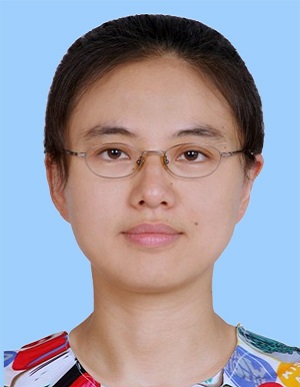
Ping Chen (Guest), Ph.D, Prof.
-
Member of the Youth Innovation Promotion Association of CAS
Research Interests: Epigenetic regulation of higher-order chromatin structure
Email: chenping@ibp.ac.cn
Tel: 010-64856269
Address: 15 Datun Road, Chaoyang District, Beijing, 100101, China
Chinese personal homepage
- Biography
1998.09 - 2002.06 B.Sc. in Chemistry, Wuhan University, China
2002.09 - 2005.06 M.Sc. in Analytical Chemistry, Wuhan University, China
2005.10 - 2009.06 Ph.D. in Biomolecular Chemistry, University of Nottingham, UK
2009.09 - 2011.12 Assistant professor, Institute of Biophysics, Chinese Academy of Sciences
2011.12 - 2014.08 Associate professor, Institute of Biophysics, Chinese Academy of Sciences
2014.09 - 2019 Professor, Institute of Biophysics, Chinese Academy of Sciences
- Awards
- Membership in Academies & Societies
- Research Interests
In eukaryotic cells, genomic DNA is highly packaged into chromatin to fit inside the nucleus. The accessibility of DNA is dependent on the packing density of chromatin fibers. It has been clear that the plasticity of and the dynamics of higher-order chromatin compaction are key regulators of transcription and other biological processes inherent to DNA.Although the structure of nucleosomes, the fundamental repeating unit of chromatin, is clear, there is still much discussion on the higher-order levels of chromatin structure. Elucidating just how a nucleosomal array can be compacted into higher-order chromatin structures is central to understanding the dynamics of chromatin structure. We have developed the chromatin in-vitro reconstitution and structural analysis system with techniques including EM/Cryo-EM, AUC, single-molecule(sm)-magnetic tweezers, FRET/sm-FRET to investigate the structure of 30-nm chromatin fibers, their structural plasticity/dynamics and epigenetic regulations. Using our established in-vitro chromatin assembly assay and structural analysis techniques, we have successfully determined the 3D cryo-EM structures of 30-nm chromatin fibers reconstituted in vitroin the presence of linker histone H1 at resolution of about 11 ?, which clearly show a histone H1-dependent left-handed twist of the repeating tetra-nucleosomalstructural units (Science, 2014).In the meanwhile, we have investigated the effect of histone variant H2A.Z and H3.3 on chromatin structure and gene regulation, and show that H3.3 plays a critical role in enhancer and promoter regions to open chromatin structure and activate gene transcription (Genes Dev. 2013; Nucleus, 2014). It will be of particular interest for us to further investigatethe molecular mechanism on the establishment and dynamic regulation of higher-order chromatin structure, including the 30-nm chromatin fiber and heterochromatin, and their correlation with gene regulation.
- Grants
- Selected Publications
1. Ping Chen*, L. Dong*, M. Hu, Y.Z. Wang, X. Xiao, Z. Zhao, J. Yan, P.Y. Wang, D. Reinberg, M. Li#, W. Li# and G.H. Li#. Functions of FACT in Breaking Nucleosome and Maintaining Its Integrity at Single-nucleosome Level. Mol. Cell (2018) 71, 284-293
2. X. Xiao*, L. Dong*, Y. Wang*, P. Wang, M. Li, G. Li, Ping Chen# and W. Li#. Dissection of Structural Dynamics of Chromatin Fibers by Single-molecule Magnetic Tweezers. Biophys Rep (2018) 4, 222-232
3. Ping Chen, G.H. Li. Structure and Epigenetic Regulation of Chromatin Fibers. Cold Spring HarbSymp Quant Biol (2017) doi: 10.1101/sqb.2017.82.033795.
4. W. Li*, Ping Chen*, J. Yu, L. Dong, D. Liang, J.X. Feng, J. Yan, P.Y. Wang, Q. Li, Z. Zhang, M. Li and G.H. Li. FACT remodels the tetranucleosomal unit of chromatin fibers for gene transcription. Mol. Cell (2016)64, 120-133 (* co-first author)
5. Q. Fang*, Ping Chen*, M. Wang, J. Fang, N. Yang, G.H. Li and R.M. Xu. Human cytomegalovirus IE1 alters the higher-order chromatin structure by targeting the acidic patch of the nucleosome. eLife (2016),5:e11911
6. F. Song*, Ping Chen*, D.P. Sun, M.Z. Wang, L.P. Dong, D. Liang, R.M. Xu, P. Zhu and G.H. Li. Cryo-EM study reveals a left-handed double helical structure of 30 nm chromatin fiber twisted by tetra-nucleosomal units. Science, (2014) 344, 376-380
7. Ping Chen, P. Zhu and G.H. Li. New insights into the helical structure of 30-nm chromatin fibers. Protein. Cell. (2014) 5, 489-491
8. Ping Chen*, Y. Wang* and G.H. Li. Dynamics of histone variant H3.3 and its coregulation with H2A.Z at enhancers and promoters. Nucleus(2014) 5, 1-7.
9. Ping Chen*, J.C Zhao*, Y. Wang*, H.Z Long, D. Liang, L. Huang, Z.Q. Wen, W. Li, X. Li, H.L. Feng, H.Y. Zhao, P. Zhu, M. Li, Q.F. Wang and G.H. Li. H3.3 actively marks enhancers and primes gene transcription via opening higher-ordered chromatin. Genes Dev. (2013) 27, 2109-2124
10. Ping Chen*, J.C. Zhao*, and G.H. Li. Histone variants in development and diseases. J Genet. Genomics. (2013) 40, 355-365
11. D.P Sun, F. Song, L. Huang, K. Zhang, G. Ji, Ping Chen# and P. Zhu#. In vitro assembly and electron microscopic analysis of 30 nm chromatin fibers. Prog. Biochem. Biophys.(2013) 40, 739-747 (# co-corresponding author)
12. G. Yuan, B. Ma, W. Yuan, Z. Zhang, Ping Chen, X. Ding, L. Feng, X. Shen,S. Chen, G.H. Li, and B. Zhu. Histone H2A ubiquitination inhibits the enzymatic activity of H3 lysine 36 methyltransferases. J. Biol. Chem. (2013) 288, 30832-30842.
13. C.P. Liu, C.Y. Xiong, M.Z. Wang, Z.L. Yu, N. Yang, Ping Chen, Z.G. Zhang, G.H. Li, R.M. Xu.Structure of the variant histone H3.3–H4 heterodimer in complex with its chaperone DAXX. Nat. Struct. Mol. Biol. (2012) 19,1287-1292
14. C. Wang,J.Shen, Z.Yang, Ping Chen, B.Zhao, W.Hu, W.Lan, X.Tong, H.Wu, G.H.Li, C.Cao.Structural basis for site-specific reading of unmodified R2 of histone H3 tail by UHRF1 PHD finger. Cell Research(2011) 21,1379-1382
15. Ping Chen, C.L. Evans, J.D. Hirst and M.S. Searle.Structural insights into the two sequential folding transition states of the PB1 domain of NBR1 from Φ value analysis and biased molecular dynamics simulations. Biochemistry.(2011) 50, 125-135
16. Ping Chen and G.H. Li. Dynamics of the higher-order structure of chromatin. Protein. Cell. (2010) 1, 967-971
17. Ping Chen, J. Long and M.S. Searle.Sequential barriers and an obligatory metastable intermediate define the apparent two-state folding pathway of the ubiquitin-like PB1 domain of NBR1. J. Mol. Biol.(2008) 376, 1463-1477.
18. Ping Chen, H.H. Liu, C. Ran, Z.L. Zhang, D.W. Pang, Z.X. Xie, H.Z. Zheng, Z.X. Lu. Visualized investigation of yeast transformation induced with Li+ and polyethylene glycol. Talanta(2008) 77, 262-268
(From Ping Chen, March 25, 2019)

